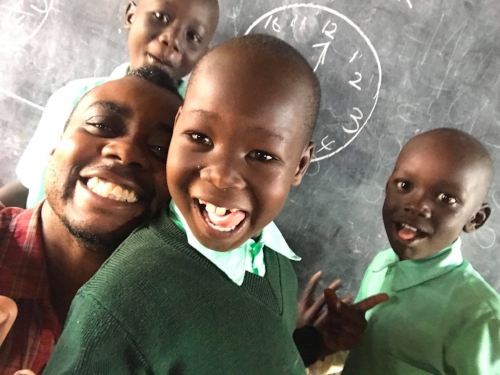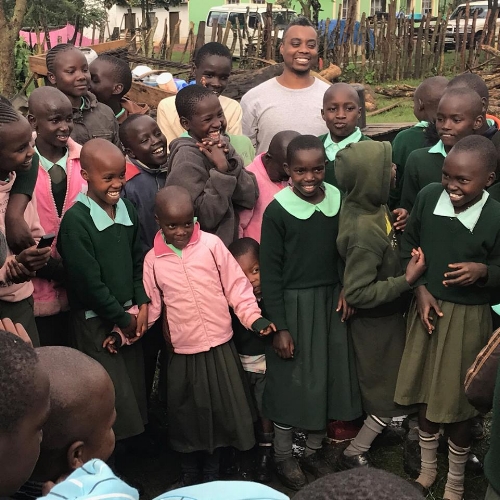Earlier this month I had the honor of traveling on a service learning trip to Daylight Center and School in Kenya with 17 other members of my congregation and surrounding community. The trip changed my life and will forever influence how I pastor. Here are 3 lessons I learned from my time in Africa…

1. There is Beauty Everywhere If We Wish to See It
Each American was paired with a Kenyan educator or leader, and it was the expectation that we assist them with their classes, service projects, or school duties for the week. In addition to there being 18 of us, I was the only African American. From the onset, Kenyan children and adults were caught off guard by the realization that there are Black people in different places around the world. Additionally, many held a common view that Americans are somehow superior to Kenyans.
The history of British Colonialism has shaped how Kenyans view themselves in relation to people with white skin, and the students at the school revealed to me on our first day that they assumed all Americans are white and that a common perception is that Americans are culturally superior. What I don’t think any of us anticipated was their reaction to meeting a Black American for the first time. For many, this was the first time that cultural superiority was associated with Black skin.
It was surprisingly refreshing to live for two weeks in a society where I was both among the racial majority and from a higher socioeconomic class. And while I am not rich nor of the majority here in the States, I will always visit a country as a generous guest who appreciates the beauty, diversity, and natural resources each country has to offer.

2. Together We Can Shape and Design Our Lived Experiences
At Daylight, there is Religious Education, Ethics and History lessons are woven throughout their English, Swahili, Math, Physical Education, Political Science and Social Studies classes. Spiritual practices and reverence for God contribute to their sense of motivation and is spoken about openly, and the expectation that it takes a literal village to raise a child is a cooperative way of living that has dramatically altered their community and way of life. Students and teachers alike seem grounded in a mutual understanding of and commitment to a shared identity.
This observation leads me to wonder how the church might prioritize each person from the church community and neighborhood as partners belonging to a “tribe”, designing education and programming to perpetuate and strengthen our understanding of and commitment to a shared identity. For years, the generations of church leaders before us focused so much energy and resources on declining worship attendance that they missed opportunities to engage in fruitful relationships with the people in their neighborhoods. There certainly exists several successful models of church that still prioritize Sunday morning worship attendance as the primary indicator of congregational vitality. There are also churches that, like Daylight Center and School, function as multipurpose community service sites that prioritize ongoing neighborhood partnerships along with attendance at programs and events as metrics by which to measure overall congregational health and vitality.

3. Our Metrics of Success Determine Our Impact
The road between the conception of a goal and its achievement can be challenging and littered with opportunities for growth and reflection. Daylight Center and School started 10 years ago with 30 orphaned students and $250. Today, the school has two campuses, over 400 students, and is rated among the top schools in Kenya for academic achievement. The school is time and again fulfilling its mission, which is to “educate a new generation of leaders to serve and transform their communities and inspire sustainable livelihood.”
This brings to mind Habakkuk 2:2 in which the writer proclaims, “Then the Lord answered me and said: Write the vision; make it plain on tablets, so that a runner may read it.” The vision for Daylight was palpable all around the surrounding neighborhood and greeted us each day as we arrived. The energy could be felt through the morning assembly and flag ceremony, the countless hours of study and programs, the abundance of laughter and smiles, meal times, physical fitness exercises, and the commitment modeled by staff and teachers.
Daylight Center and School is located on a beautiful plot of land in the nomadic countryside of Kenya. The surrounding desert is home to many tribes who would otherwise have no access to education and couldn’t afford to travel to more developed parts of the country, so the existence of Daylight is integral to the future sustainability of surrounding tribes. Everyone in the community knows what Daylight is and what happens there, and is committed to the mission of the school because of what it means for their future. I want the same to be said for our church.

I want to know the people in our neighborhood. I want them to help design what happens at our church. I want the people in our neighborhood to connect what happens at our church with meeting or fulfilling a need in their lives. I want to model commitment in such a way that our ministry impact becomes synonymous with our ministry success and everyone who benefits is committed to our shared identity and sustaining our future, together.
My time serving and learning in Kenya was rich and deeply transformative. The thousands of pictures, dozens of journal entries, and hours of video can’t even begin to capture how this experience has been for my life and ministry. I am deeply grateful.
If you want to learn more about Daylight Center and School, visit http://daylightcenter.org

